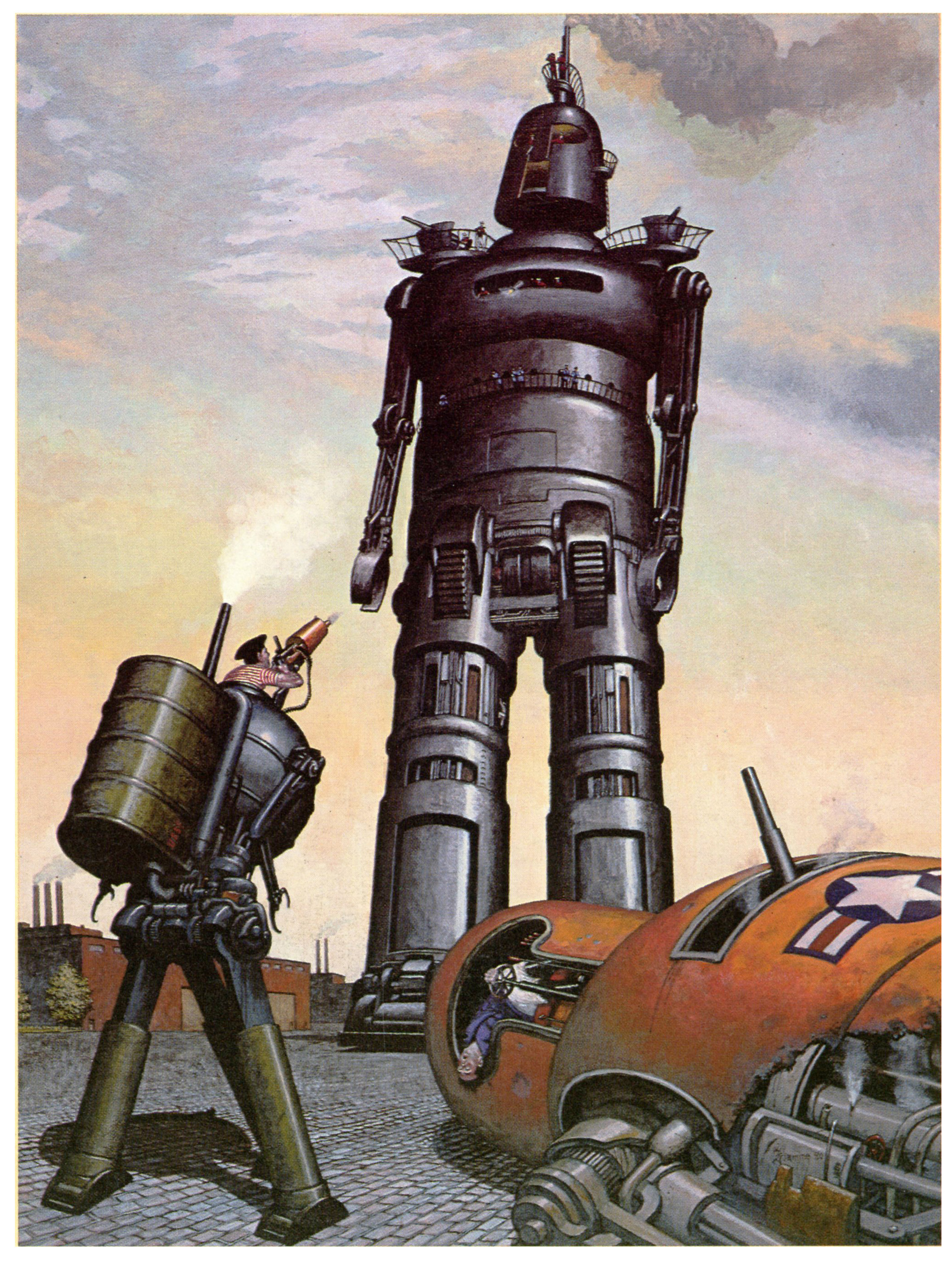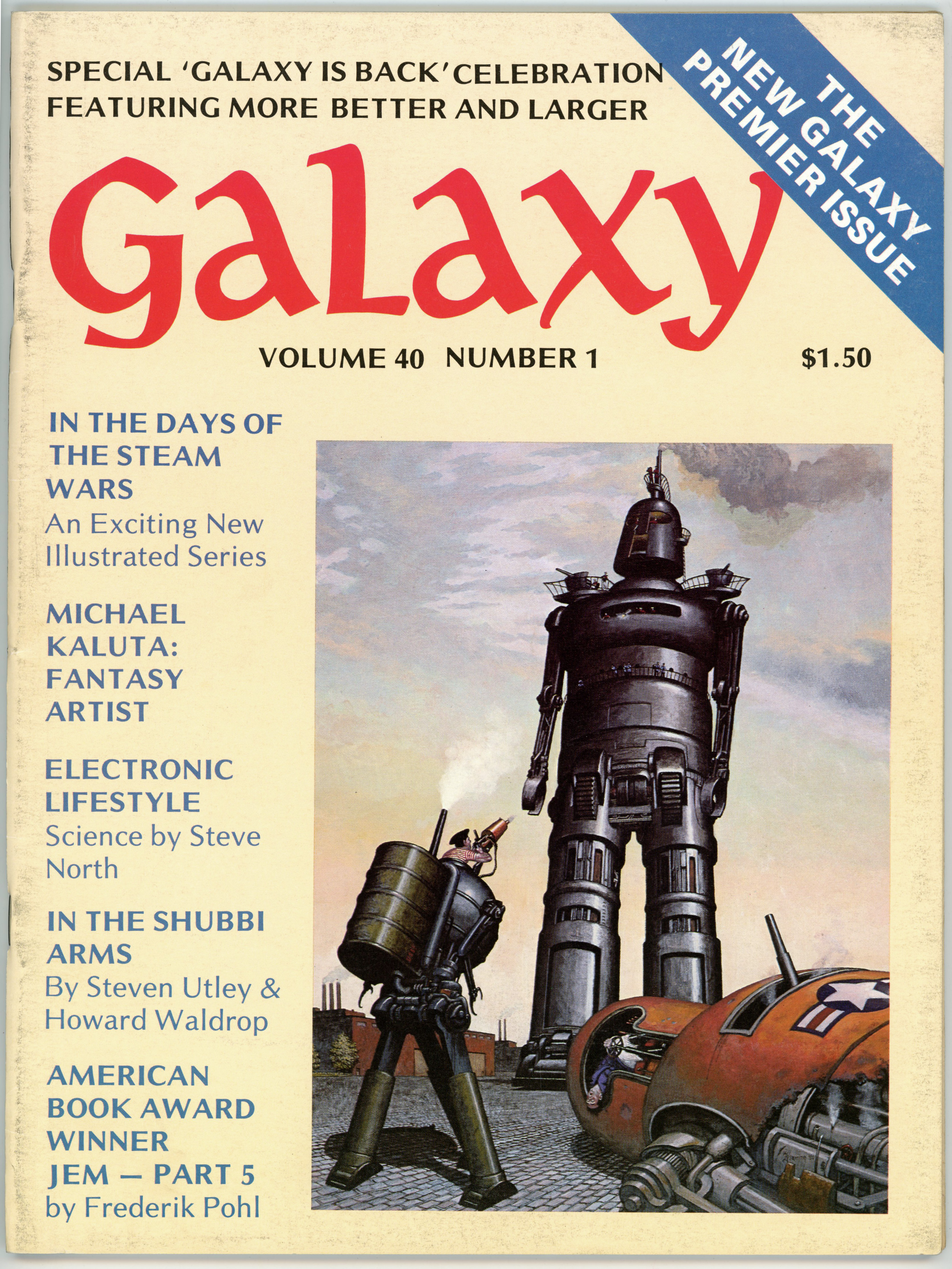I can’t get into steampunk – the very idea – but I can still appreciate the significance of a steampunk story by virtue of its having appeared in the final issue of Galaxy magazine.
The copy shown below was purchased from the late Robert Madle, from whom I obtained the December, 1942, and November, 1946, issues of Astounding Science Fiction. This was back in the former, now-perhaps-unknown, world of the 1980s. (I suppose this “dates” me, but then again, the passage of time eventually dates all men!) By virtue of having been one of the first pulps that ever came into my possession, and equally, by the sense of wonder and ambiguity inherent to A.E. van Vogt’s story – “The Weapon Shop” (an aspect of Van Vogt’s oeuvre panned by Damon Knight, and praised by Philip K. Dick … I go with PKD on this one!), and the soft mystery of Hubert Rogers’ cover art, the December ’42 issue has for me a special significance.
But, back to the final Galaxy… As described at Wikipedia, subsequent to October of 1979, …“Rights to the title were transferred to a new company, Galaxy Magazine, Inc., owned by Vincent McCaffrey, proprietor of Avenue Victor Hugo, a second-hand book store in Boston; UPD [Universal Publishing and Distribution Corporation] retained a ten percent interest in order to receive income from future sales to pay off their debts. Stine had compiled two more issues, but neither ever appeared; McCaffrey, who had also launched a separate magazine, Galileo, had cash-flow problems that prevented him from distributing the magazine as he had planned. One more issue did finally appear from McCaffrey, in July 1980, in a large format; it was edited by Floyd Kemske. A subsequent issue, to be dated October 1980 [edited by Floyd Kemske], was assembled, but never distributed.” As shown in the magazine’s issue grid at the Internet Speculative Fiction Database, “A brief revival as a semi-professional magazine followed in 1994, edited by H. L. Gold’s son, E. J. Gold; this lasted for eight bimonthly issues.”
And more: “The last few years of Galaxy‘s life were marked by stories of unpaid contributors. John Varley, for example, reported that he was still owed money for his stories five years after they appeared. Submissions from well-known writers fell away, and the lack of financial support from UPD meant that the pay rate was an unattractive one cent per word. Higher postal rates, higher paper costs, and continuing competition from the paperback science fiction market all added to the pressure on Galaxy. These problems were not resolved by the sale to McCaffrey, who did not even have enough money to pay for circulation postage, with the result that not every Galaxy subscriber received a copy of the final issue. Frederik Pohl places the blame for Galaxy‘s demise on Arnie Abramson, who, Pohl contends, “simply did not perform [the] basic functions of a publisher”: paying the authors, ensuring subscribers received copies, and meeting other obligations.”
Ita gloria publicationis transit
While oddly unavailable at the Pulp Magazine Archive, the issue is available at the Luminist Archives, and can be downloaded in PDF format here.
Notably, there’s a substantial degree of non-fiction content:
“Son of Calculator and the Electronic Lifestyle”, by Steve North, anticipating personal computing and the Internet
“Your Car and Your Computer”, by Ed Teja
“Words” – Computer acronyms and lingo
“If You Don’t Talk to Your Stereo, I Will”, by Eric Blair
“Defending the Empire: Intelligent [computer] Games”, by Ed Teja
“Careers” [in computing]
“Michael Kaluta: Storytelling Fantasy Artist”, by Floyd Kemske
“Projections – Galaxy Looks at the Making of Fritz Lang’s Classic Film Metropolis”, by Robert Stewart
Plus, an ad for the first four issues of Galileo, featuring Larry Niven’s “The Ringworld Engineers”

Cover art by Larry Blamire, for “In The Days of the Steam Wars”
 Illustration by Tom Barrett, for “The Colony”, by Raymond Kaminski (p. 21)
Illustration by Tom Barrett, for “The Colony”, by Raymond Kaminski (p. 21)
Illustration by Larry Blamire, for “In The Days of the Steam Wars” (p. 35)
Illustration by Barclay Shaw, for “Jem”, by Frederik Pohl (part 5) (p. 49)
Illustration by Tom Barrett, for poem “Mapping the Island in Images – The Four Shores, Beta Bernal, resonant orbit, 2080”, by Robert Frazier (p. 59)
Untitled Illustration by Cortney Skinner (p. 73 – interior of rear cover)
Guides to (the) Galaxy, at…
… Wikipedia (1980 Issue contents)
… The Encyclopedia of Science Fiction
… Luminist Archive (includes 1980 issue)
… The Verge (“One of the greatest science fiction magazines is now available for free online”)
… Science Fiction Short Story Reviews
Robert A. Madle, at…
… FanLore
… File770
Artists










